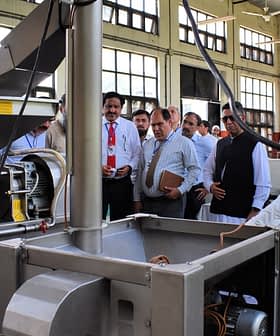Reports Find Olive Oil Companies Struggling in Spain and Italy
Two independent reports highlight some of the economic challenges facing the olive oil sectors of the world's two largest olive oil producers.
After a year of drought, decreasing production and an ebbing appetite for olive oil at home, producers are worried about the financial well-being of some companies in Spain and Italy.
Two reports — one from each country — highlight the trouble that some of these companies had last year making and maintaining adequate levels of profitability.
A deep change of mentality is needed, alongside a change in the consumers’ attitudes.
One of the reports, which was released by the financial consultancy Insight View in Spain, found that more than 12 percent of olive oil producing companies there are at high or very high risk of default. Small and micro-companies, which account for about 36 percent of the Spanish olive oil sector, were found to be at the greatest risk.
High prices have driven down domestic and international consumption. These price hikes come at a time when production costs have continued to rise and competition from abroad has grown. Net financial debt among many companies within the sector also has increased, slowly but steadily. These factors have become a source of concern for many in the industry.
Deoleo, which is considered a bellwether company for the production and export of olive oil, experienced a 32 percent decrease in their Ebitda last year; a loss of €31.3 million ($38.7 million). Ebitda is a metric used to evaluate a company’s performance that takes operating profit, depreciation and amortization expenses into account.
A spokesperson for the company said that the company’s financial performance had notably improved in spite of the contraction of their Ebitda. The group’s losses were reduced at the end of 2017 to €18.4 million ($22.7 million), which is 90 percent lower than the €179.4 million ($220.9 million) they posted in the red one year earlier.
Juan Vilar, a leading expert on the olive oil economy at the University of Jaén, said this report was not “catastrophic”, but the sector needs to adapt as the international olive oil industry is becoming increasingly modern and competitive.
“This [growing competition] is due to the increasing intensification that is being applied to olive plantations, which means higher production with lower processing costs,” he said. “That is, the greater the degree of intensification of exploitation, the greater the margin to alter prices and the greater the capacity to adapt to the market.”
Smaller producers — many of whom use more traditional, non-intensive methods of harvesting olives and producing oil — are increasingly less capable of adapting due to their high production costs, which leads to their increased risk of default.
Some investors believe that the troubles for the sector will likely get worse before they get better. They point to the bad harvest of last year, which could compound costs for producers, leading to more expenses without an increase in sales.
However, producers are also confident that their efforts to control expenses will continue to lower their operating costs, and they believe that olive oil consumption will grow again both domestically and internationally. They cite a report from the International Olive Council, which predicts a five percent growth in global consumption for the coming year.
The same issues mentioned by Vilar are also affecting the financial fortunes of Italian producers. An Italian consulting firm found that fewer than 20 olive oil producing companies are profitable. Of these companies, only eight were solely dedicated to olive oil production and their overall profits had shrunk by about five percent since 2016.
Assitol, the association of Italian olive oil producers, blame Italy’s conservative approach to olive oil for shrinking profits. Anna Cane, the Assitol olive oil group president, said that some producers are stuck in the more traditional approach and therefore are unable to expand in order to meet domestic and global demand.
“Olive growing on the typical Italian, hilly landscape bears too high costs and is still based on a fragmented production model, and on old and still not mechanized processes,” she said. “In this framework, national production, yet strongly insufficient to meet the overall demand, is not able to grow further.”
Italian producers’ treatment of olive oil may also be part of the problem. Cane said companies treat olive oil as a commodity when it should be treated as a product of great value.
By emphasizing the oil’s quality and associated health benefits, Cane believes that producers will more successfully market to countries in which demand for more expensive, higher quality olive oil is rapidly growing.
“Another core issue is certainly the approach to the market,” she said. “[Olive oil] has become an ‘undifferentiated product’, whose only relevant indicator is its price, ignoring the quality offered or the sensorial characteristics of the many varieties produced in Italy.”
As Cane points out, these challenges will not be overcome by individual producers. She believes it will take a larger culture shift in order to modernize the sector and adapt to the changing international markets. The same is widely true in Spain.
“An Italian entrepreneur, alone, cannot do very much,” Cane said. “A deep change of mentality is needed, alongside a change in the consumers’ attitudes.”








